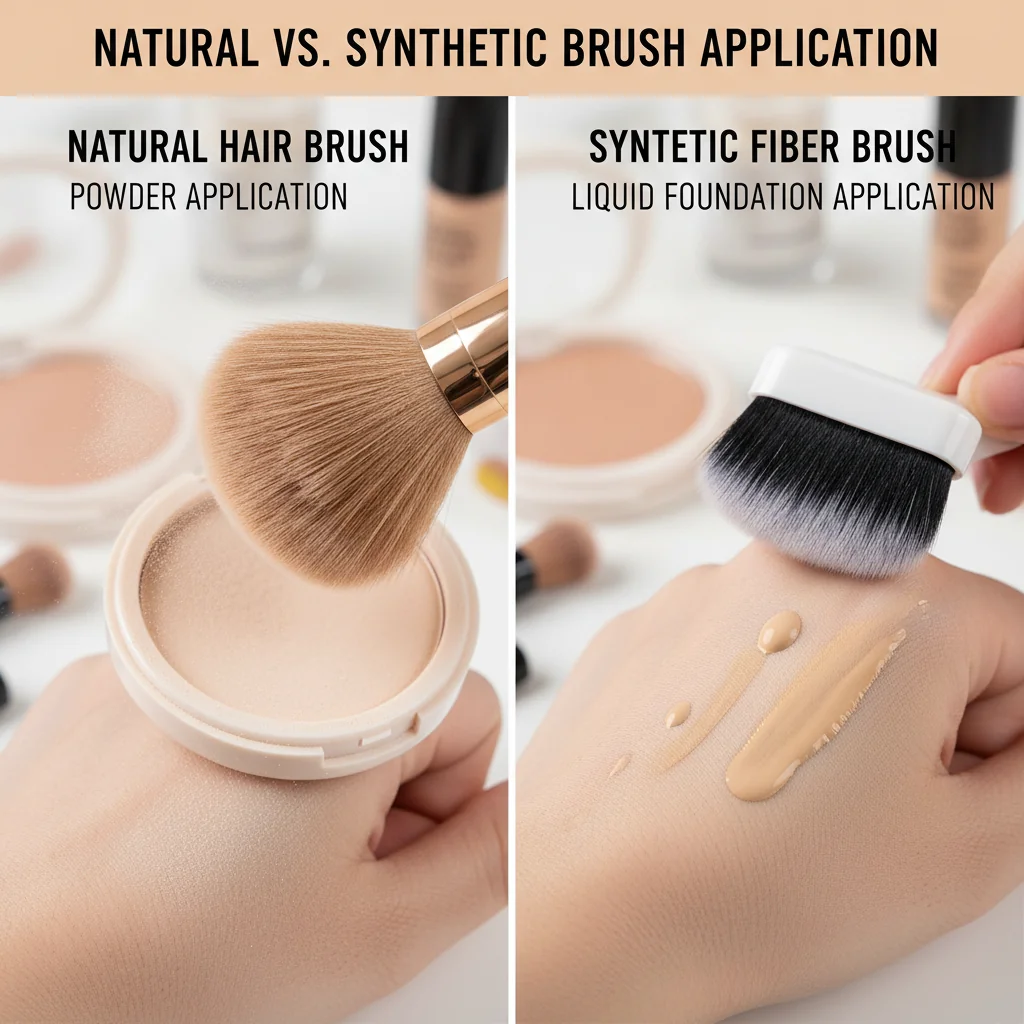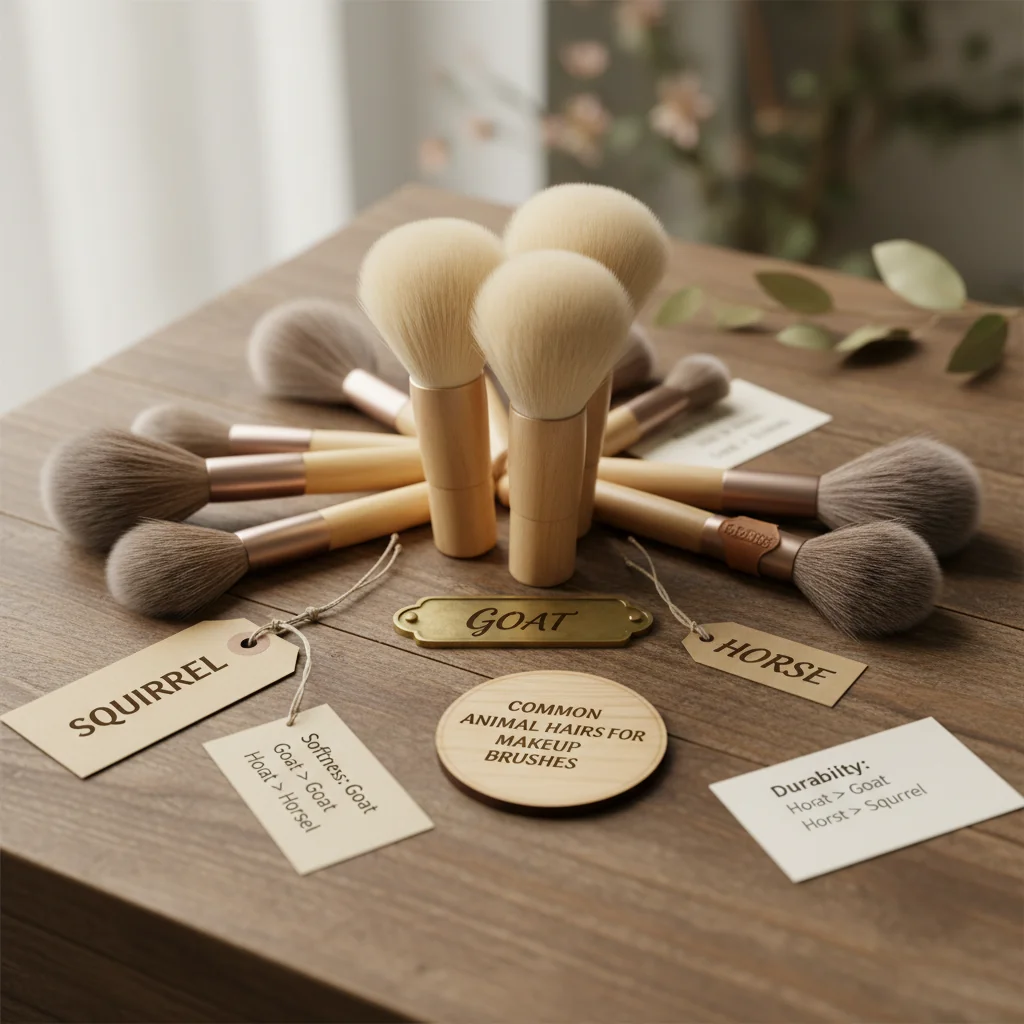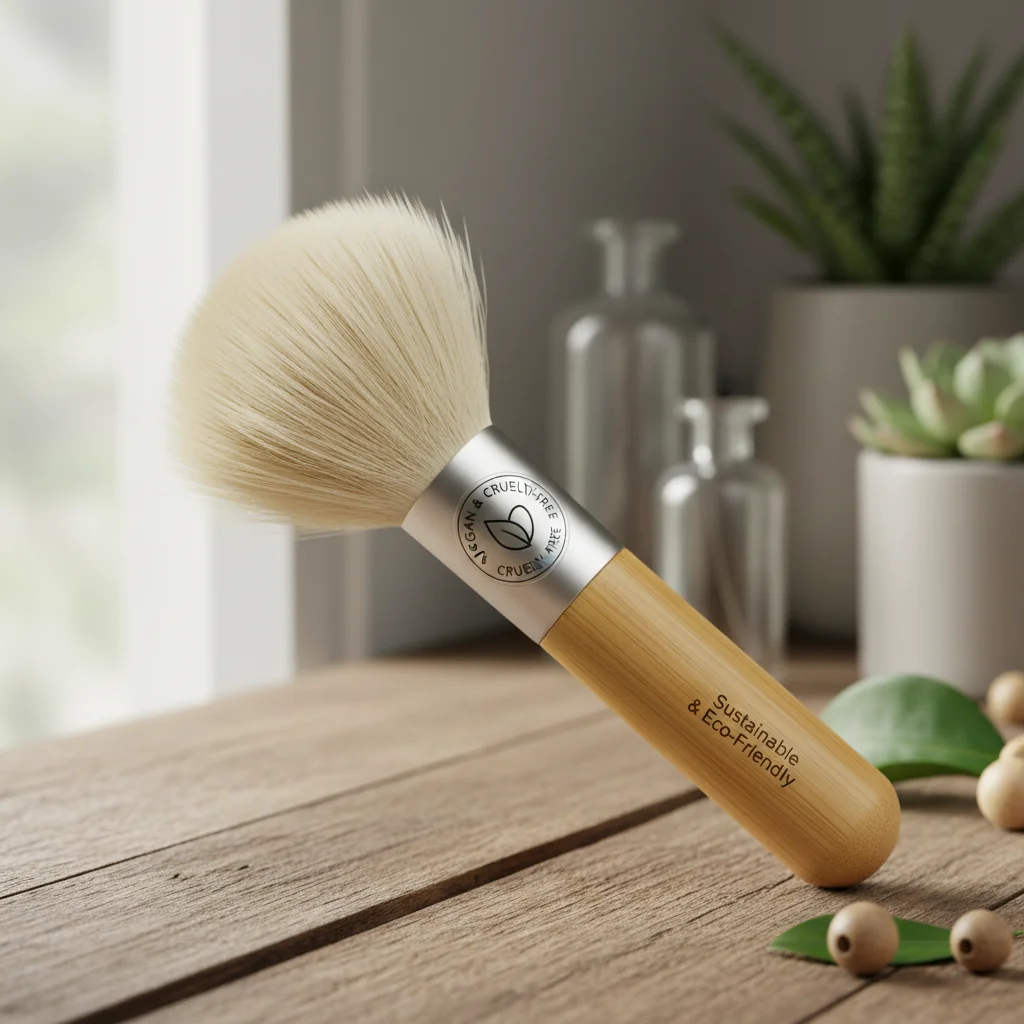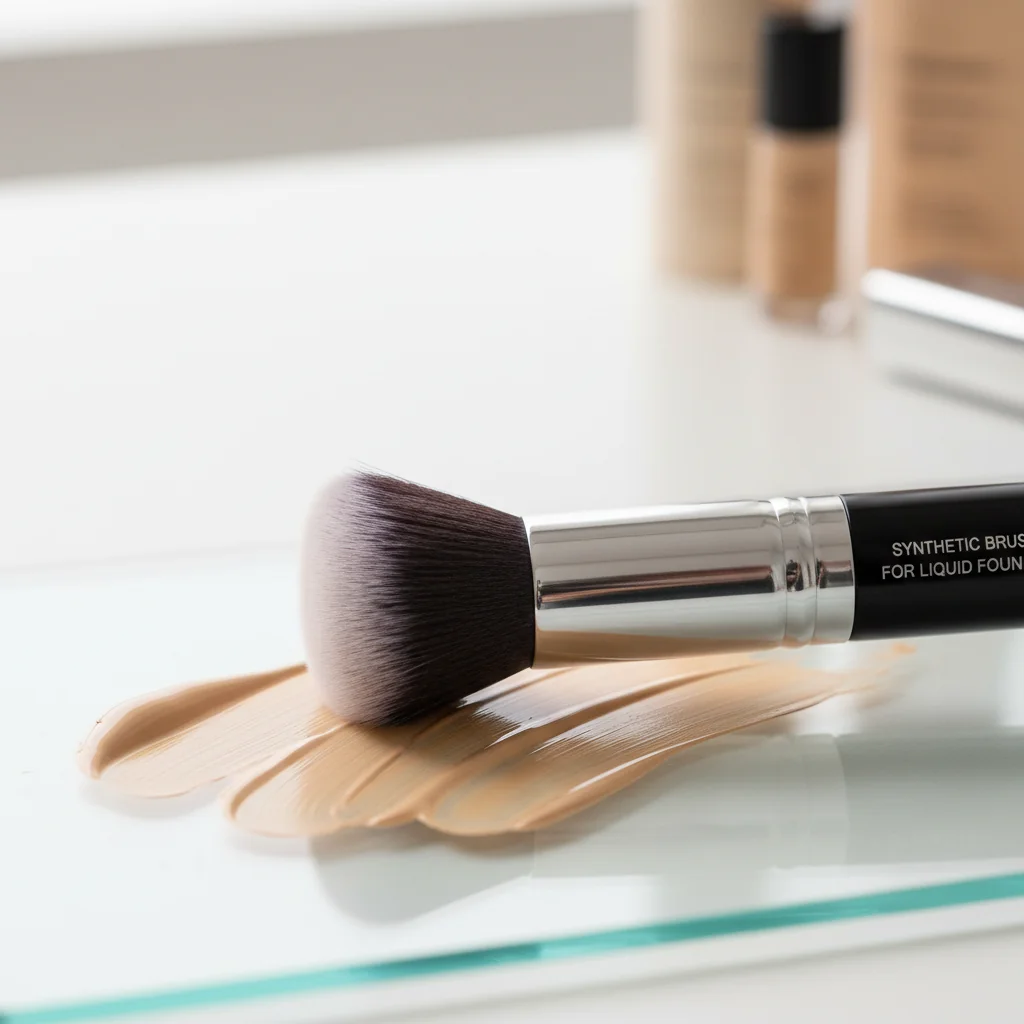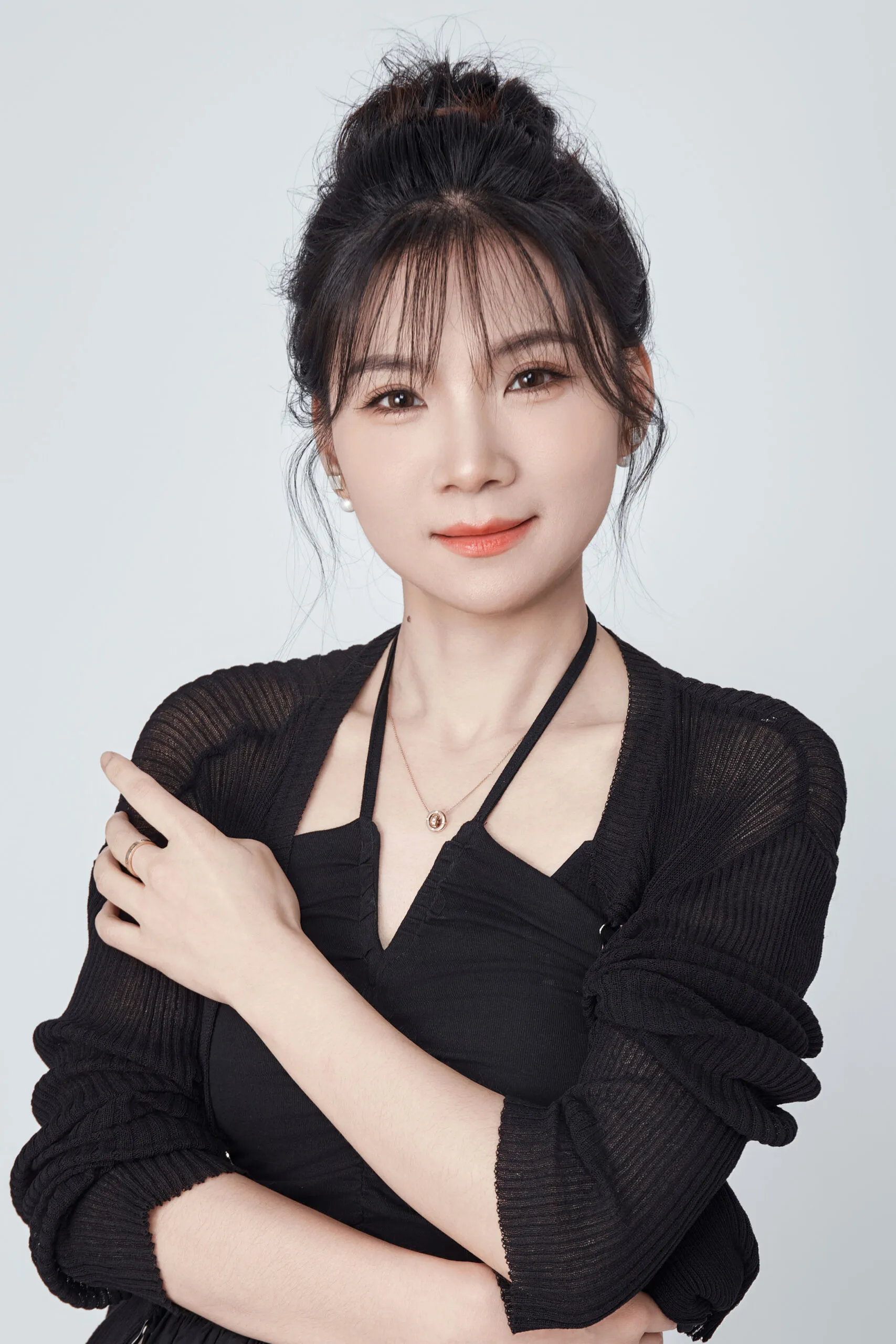Choosing the wrong bristle can sink your product line before it even launches. It leads to poor performance, bad reviews, and wasted investment. I’ll show you how to pick the right material every time.
Makeup brush bristles are made from either natural animal hair1 (like goat, squirrel, or horse) or synthetic fibers (usually PBT or taklon). Natural hair is great for powders, while synthetics excel with liquids and creams, are easier to clean, and are the standard for vegan-friendly lines.
When I first started working on the factory floor, the biggest lesson I learned was how a tiny change in bristle material2 could completely transform a brush’s performance and cost. This choice is the foundation of your product’s success. It affects everything from application finish and durability to your brand’s ethical claims and profit margins. For brand founders and sourcing managers like you, getting this right is not just a detail—it’s a core business decision. In this guide, I’ll walk you through everything you need to know to make smart, confident choices for your OEM or private label brush line.
The global vegan cosmetics market was valued at $12.9 billion in 2021 and is expected to grow at a CAGR of 6.3% through 2030.True
This data, reported in 2024, highlights the strong and growing consumer demand for vegan products, making vegan brushes a strategic choice for brands.
All natural hair brushes are cruel to animals.False
Many manufacturers, especially in the fude tradition, source natural hair as a by-product of other industries, like food or wool. However, brands must demand traceability documentation to validate any cruelty-free claims.
What type of bristles are best for makeup brushes?
Struggling to decide between natural and synthetic bristles for your brush line? This choice impacts performance and your brand’s message. I’ll help you understand which material aligns with your specific product goals.
The best bristle type depends entirely on the formula you want to apply. Natural hair, with its porous cuticles, is unmatched for picking up and diffusing powder products. Modern synthetic bristles are non-porous, making them the superior choice for liquid and cream formulas, plus they’re durable and hygienic.
Choosing the "best" bristle isn’t about finding a single winner; it’s about creating a perfect match between the tool and the task. As a brand owner, you need to think about the end-user experience. Will your customer be applying a sheer finishing powder or a full-coverage cream foundation? The answer dictates your material choice. From my experience helping hundreds of brands, the most successful lines are those that offer a clear purpose for each brush. A portfolio that leads with high-performance synthetics for complexion and adds a niche, premium natural hair brush for powder enthusiasts often strikes the perfect balance between market trends, cost, and performance.
Bristle Material Comparison
To make this easier, I’ve broken down the key differences in a table. This is the kind of at-a-glance information I use with my clients to help them make fast, effective sourcing decisions.
| Bristle Type | Best For | Pros | Cons | Maintenance | Cost Tier |
|---|---|---|---|---|---|
| Goat Hair | Powders (blush, bronzer) | Excellent pickup & blending, durable | Can be coarse if low-grade, absorbs product | Moderate; gentle washing | Mid to High |
| Squirrel Hair | Powders (finishing, highlight) | Extremely soft, sheer application | Very delicate, low durability, expensive | Low; minimal washing | Very High |
| Horse/Pony Hair | Powders (eyeshadow) | Good pickup, affordable | Can be stiff, potential for allergens | Moderate | Low to Mid |
| Synthetic (PBT/Taklon) | Liquids, Creams, Gels | Durable, hygienic, non-absorbent, vegan | Older types could be stiff or streaky | High; tolerates frequent washing | Low to Mid |
| Micro-Taper Synthetic | Powders & Liquids | Mimics natural softness, versatile, vegan | Higher cost than basic synthetics | High; tolerates frequent washing | Mid-Range |
All synthetic brushes perform the same.False
Modern synthetic fibers, like micro-tapered PBT, are engineered with varied diameters, crimp patterns, and tip treatments to mimic the powder-pickup capabilities of natural hair, making them far more versatile than older nylon bristles.
In 2025 product testing, all major consumer brush sets reviewed by sources like the NYT Wirecutter were made with synthetic bristles.True
This reflects a massive industry shift toward synthetics for their value, durability, hygiene, and alignment with vegan and cruelty-free marketing claims.
What animal hair is used for makeup brushes?
You’ve seen "natural hair" on labels, but what does that actually mean? The specific animal source determines a brush’s softness, performance, and price. Let’s clarify what you’re really sourcing.
The most common animal hairs used in makeup brushes are goat, squirrel, horse (or pony), and weasel (often called kolinsky). Each has a unique structure and purpose, from soft, delicate squirrel for finishing powders to resilient goat hair for blending blush and bronzer.
When you’re specifying brushes for your brand, especially for a premium powder line, knowing the grades within each hair type is critical. It’s a detail many factories won’t explain unless you ask. For example, with goat hair, you can specify different grades like saikoho or sokoho, which refer to the softness and fineness of the hair. Saikoho is incredibly soft and luxurious, ideal for a high-end finishing brush. Cheaper grades might feel prickly and lead to a poor customer experience. For squirrel hair, the source (e.g., blue squirrel vs. gray squirrel) affects the softness and price. As a buyer, you must be precise in your RFQ. Always ask for the specific grade and request that the natural tips of the hair remain uncut, as this preserves the incredible softness that makes natural brushes so sought after.
Common Natural Hair Types:
- Goat Hair: The workhorse of natural brushes. It has great resilience and picks up powder pigment effectively. It’s perfect for blush, bronzer, and blending brushes where you want to build color.
- Squirrel Hair: The pinnacle of softness. Its fine, delicate tips provide a sheer, airbrushed finish. This makes it ideal for applying highly pigmented products or for a light dusting of finishing powder. However, it’s very fragile and requires gentle care.
- Horse/Pony Hair: Often blended with other fibers, horse hair is a more affordable natural option. It’s firmer than goat hair and works well for eyeshadow brushes where you need a bit more stiffness to pack on color.
- Weasel/Kolinsky: Traditionally prized for its spring and fine point, this hair is excellent for detail work like eyeliner or lipstick. However, sourcing kolinsky is now fraught with ethical and legal complexities, pushing most brands toward high-performance synthetic alternatives.
What makes a makeup brush vegan?
Your customers are demanding vegan products, but what does that mean for a makeup brush? It’s more than just the bristles. A truly vegan brush requires a supply chain that avoids all animal products.
A makeup brush is considered vegan if it contains no animal-derived components. This primarily means using synthetic bristles (like PBT or taklon) instead of animal hair. It also means ensuring the glue used to secure the bristles and any handle finishes are free from animal by-products.
For brand owners like Emily, a "vegan" claim is a powerful marketing tool, but it comes with responsibility. One of the biggest pain points I see is factories that make claims without providing proof. When you’re sourcing vegan brushes, you must go beyond the supplier’s word. Ask for a materials declaration3 for every single component of the brush—the bristles, the ferrule, the handle, and especially the glue. Some traditional glues can contain animal-derived ingredients. A reliable OEM/ODM partner like Brushino will have this documentation ready and understands the importance of transparency. This not only protects your brand’s integrity but also gives you the confidence to market your products authentically to a customer base that values ethical sourcing. The trend is clear: the vegan cosmetics market is booming, and having certified vegan tools is no longer a niche, but a mainstream expectation.
Which bristles should I specify for liquid and cream formulas?
Using the wrong brush for your new liquid foundation or cream blush can lead to a streaky, cakey mess. Your customers will blame your product, not the tool. So, what’s the right choice?
For any liquid, cream, or gel formula, you should always specify synthetic bristles. Materials like PBT and taklon are non-porous, meaning they don’t absorb and waste your product. They provide a smooth, seamless application and are far easier to clean and sanitize.
When you send an RFQ (Request for Quotation) to a factory for a liquid or cream brush, being specific is key to getting the performance you want. Don’t just say "synthetic." I guide my clients to specify the technical details that matter. For a foundation brush, you might request a dense bundle of PBT fibers with a specific denier mix (a mix of fiber thicknesses) and a high percentage of micro-tapered tips. This combination provides both coverage and a smooth, streak-free finish. For a concealer brush, you might want a different density and shape. You can also specify the crimp pattern4 of the fibers, which affects how the bristles hold their shape and splay on the skin. Providing these specs ensures the samples you receive match your vision and prevents the common pain point of receiving a generic, underperforming brush. This level of detail is what separates a professional-grade tool from a cheap giveaway.
OEM Spec Checklist for Synthetics:
- Fiber Type: PBT is the modern standard for its softness and durability.
- Denier Mix: Specify a blend of fiber thicknesses to control density and softness.
- Taper Percentage: A higher percentage of micro-tapered tips creates a softer feel and better blending.
- Crimp Pattern: Request a specific wave or texture to influence how the brush picks up and applies product.
- Bundle Density & Shape: Define how tightly the bristles are packed and the final shape of the brush head (e.g., angled, flat-top, domed).
Conclusion
Choosing the right bristle is simple: use modern synthetics for liquids and creams, and reserve high-grade natural hair for specific, niche powder applications. This strategy ensures performance, hygiene, and market relevance.
References
-
Explore the advantages of using natural animal hair in makeup brushes for optimal performance and application. ↩
-
Understand how the choice of bristle material affects makeup application and overall product performance. ↩
-
Find out why a materials declaration is crucial for ensuring the ethical sourcing of makeup brushes. ↩
-
Discover how the crimp pattern of bristles influences makeup application and brush effectiveness. ↩
